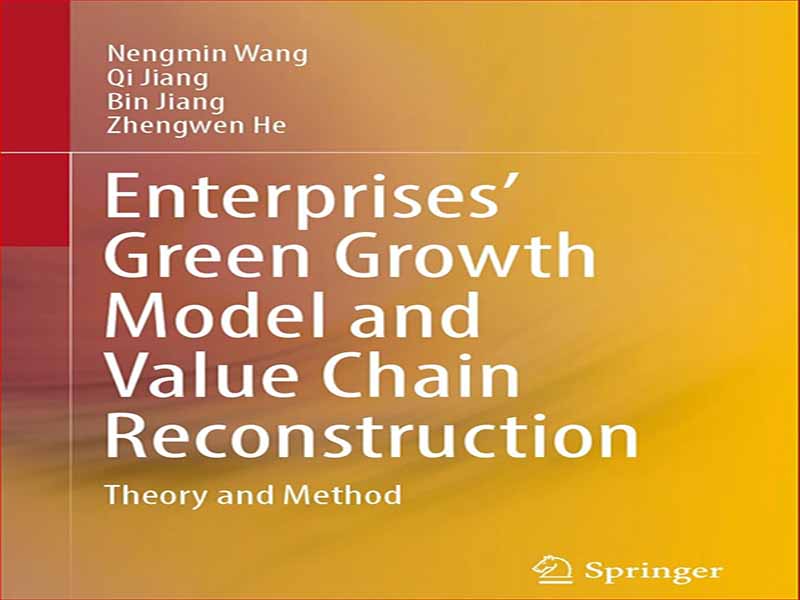- عنوان مجله: Enterprises’ Green Growth Model and Value Chain Reconstruction
- نویسنده: Nengmin Wang
- حوزه: ارزش سازمانی
- سال انتشار: 2022
- تعداد صفحه: 444
- زبان اصلی: انگلیسی
- نوع فایل: pdf
- حجم فایل: 4.44 مگابایت
تنش بین منابع، محیط زیست و جمعیت به طور فزاینده ای آشکار می شود زیرا مسائل زیست محیطی به چالشی بزرگ برای توسعه پایدار جهانی تبدیل می شود. تضمین پایداری زیست محیطی یکی از مهمترین اهداف اهداف توسعه هزاره سازمان ملل است. تعادل بین رشد اقتصادی و سازگاری با محیط زیست، کلید مدل رشد اقتصادی است. تاریخ توسعه جهانی ثابت کرده است که استراتژی “اول رشد، بعد پاکسازی” برای دنبال کردن رشد اقتصادی به قیمت دوستی محیط زیست پایدار نیست و منجر به تخریب محیط زیست و هزینه های بالای حاکمیتی می شود. توسعه سبز برای دولت ها، شرکت ها، افراد و سازمان های غیردولتی نگرانی زیادی دارد. شی جین پینگ، رئیس جمهور چین، اهمیت زیادی برای توسعه سبز قائل است و اذعان داشت که “آب های شفاف و کوه های سبز به خوبی کوه های طلا و نقره هستند” و اعلام کرد که چین قبل از سال 2030 به اوج انتشار دی اکسید کربن و قبل از سال 2060 بی طرفی کربن خواهد رسید. ، نشان دهنده قصد چین برای افزایش تعهدی است که تحت توافق پاریس در مورد تغییرات آب و هوایی انجام داده است. توسعه سبز زیربنای دستیابی به اهداف استراتژیک اوج گیری کربن و بی طرفی کربن است. چگونگی اجرای توسعه سبز و تضمین پایداری زیست محیطی یک موضوع داغ در دانشگاه و صنعت بوده است. بنگاه ها واحد اساسی توسعه سبز هستند. اجرای مدل رشد سبز برای دستیابی به مزیت های رقابتی و به دست آوردن یک پارادایم برد-برد برای عملکرد تجاری و عملکرد محیطی حیاتی است. از سال 2000، تیم ما درگیر تحقیق در مورد زنجیره تامین سبز/حلقه بسته و عملیات و مدیریت پایدار بوده است، که عمدتا بر تصمیم گیری عملیاتی و بهینه سازی زنجیره تامین حلقه سبز/بسته تمرکز دارد. دستاوردهای ما و دلیل ماندگاری ما در این زمینه را می توان به منابع مختلفی نسبت داد. ما از حمایت بنیاد ملی علوم طبیعی چین (NSFC) و برنامه دانش پژوه Changjiang وزارت آموزش و پرورش جمهوری خلق چین که کمک های اساسی به تیم ما ارائه کردند سپاسگزاریم. ما همچنین از پیشینیان دانشگاهی و همکاران خود به خاطر راهنمایی هایشان در زمینه مرزهای نظری، هنجارهای تحقیق و روش ها سپاسگزاریم. علاوه بر این، ما از حمایت و مشارکت شرکت ها قدردانی می کنیم. با تشکر ویژه از Everbright Environment Group Ltd. که فرصت هایی را برای درک نیازهای واقعی شرکت ها و اصلاح مسائل علمی در اختیار ما قرار می دهد. با توجه به همکاری قابل توجه با Everbright، ما توانستیم پیش نویس دستورالعمل People-First Waste to Energy PPP را برای انتشار برنامه توسعه سبز چین در سراسر جهان تهیه کنیم. این مونوگراف محصول یک پروژه تحقیقاتی است که توسط پروژه کلیدی بنیاد ملی علوم طبیعی چین “تحقیق در مدل رشد سبز بنگاه ها و بازسازی زنجیره ارزش” تحت گرنت 71732006 و پروژه اصلی بنیاد ملی علوم طبیعی چین تامین شده است. “ارتباط رابط و مدیریت بهینه سازی لجستیک سیستم صنعتی تولید – گردش” تحت گرنت 72192830/72192834. این مجموعه تحقیقات قبلی ما است. مدل رشد سبز سازمانی و بازسازی زنجیره ارزش به طور سیستماتیک و جامع مفهوم، مدل سیستم، مدل پیادهسازی و محیط عملیاتی مدل رشد سبز را برای شرکتها مطالعه میکند و درک جامعه دانشگاهی و صنعت از مدل رشد سبز را تسهیل میکند. بهینه سازی شبکه لجستیک یکپارچه بر اساس ساخت مجدد: نظریه و روش و بهینه سازی مسیریابی وسایل نقلیه برای حمل و نقل مواد خطرناک: نظریه و روش، که به زبان چینی منتشر شده است، بخشی از یک سری تک نگاری است که به مدل رشد سبز برای شرکت های تولید مجدد می پردازد. چشم اندازهای پایداری و ایمنی این دو کتاب با ارائه تصمیمات عملیاتی خاص، مانند شبکههای لجستیک و مسیرهای خودرو، پشتیبانی روششناختی را ارائه میکنند و به عنوان مرجع تصمیمگیری برای شرکتها برای اجرای مدل رشد سبز عمل میکنند.
The tension between resources, environment, and population is becoming increasingly pronounced as environmental issues become a major challenge for global sustainable development. Ensuring environmental sustainability is one of the most important goals of the United Nations Millennium Development Goals. The balance between economic growth and environmental friendliness is the key to the economic growth model. The history of global development has proved that the “grow first, clean up later” strategy of pursuing economic growth at the expense of environmental friendliness is not sustainable, leading to environmental degradation and high governance costs. Green development is of great concern to governments, enterprises, individuals, and NGOs. Chinese president Xi Jinping has attached great importance to green development, recognizing that “clear waters and green mountains are as good as mountains of gold and silver,” and announced that China would achieve a peak in carbon dioxide emissions before 2030 and carbon neutrality before 2060, signaling China’s intention to increase the commitment it made under the Paris Agreement on climate change. Green development is the foundation for achieving the strategic goals of carbon peaking and carbon neutrality. How to implement green development and ensure environmental sustainability has been a hot issue in academia and in industry. Enterprises are the basic unit of green development; implementation of the green growth model is critical to attain competitive advantages and obtain a win-win paradigm for business performance and environmental performance. Since 2000, our team has been engaged in the research of green/closed-loop supply chain and sustainable operation and management, mainly focusing on operational decision-making and optimization of green/closed-loop supply chain. Our achievements, and the reason we can persist in this field, can be attributed to various sources. We are grateful for the support of the National Natural Science Foundation of China (NSFC) and the Changjiang Scholar Program of the Ministry of Education of the PRC, which provided essential help to our team. We are also thankful for our academic predecessors and colleagues for their guidance on the theoretical frontier, research norms, and methods. In addition, we appreciate the support and participation of the enterprises. A special thanks to Everbright Environment Group Ltd. for providing us opportunities to understand enterprises’ realistic needs and refine scientific issues. Due to substantial cooperation with Everbright, we were able to draft the People-First PPP Waste to Energy Guideline to disseminate China’s green development program worldwide. This monograph is the product of a research project funded by the Key Project of the National Natural Science Foundation of China “Research on Enterprises’ Green Growth Model and Value Chain Reconstruction” under Grant 71732006 and the Major Project of the National Natural Science Foundation of China “Interface Connection and Logistics Optimization Management of the Manufacture-Circulation Industrial System” under Grant 72192830/72192834. It is the cumulation of our previous research. Enterprises’ Green Growth Model and Value Chain Reconstruction systematically and comprehensively studies the concept, system model, implementation model, and operational environment of the green growth model for enterprises, facilitating the academic community and industry’s understanding of the green growth model. Optimization of Integrated Logistics Network Based on Remanufacturing: Theory and Method and Vehicle Routing Optimization for Hazardous Materials Transportation: Theory and Method, which we have published in Chinese, are part of a series of monographs delving into the green growth model for enterprises from remanufacturing, sustainability, and safety perspectives. By providing specific operational decisions, such as logistics networks and vehicle routes, those two books provide methodological support and serve as decision-making references for enterprises to implement the green growth model.
این کتاب را میتوانید از لینک زیر بصورت رایگان دانلود کنید:
Download: Enterprises’ Green Growth Model and Value Chain Reconstruction




































نظرات کاربران